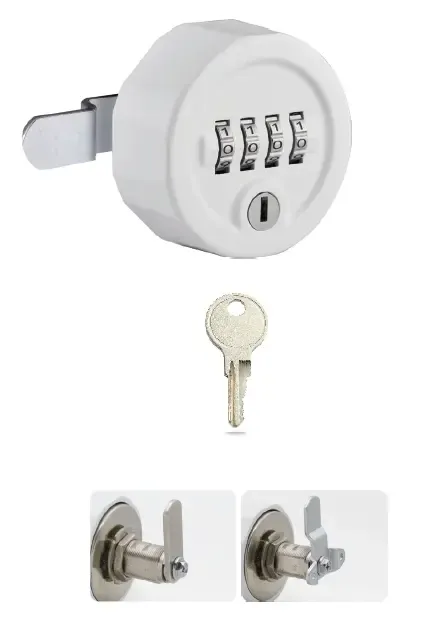Security has always been a fundamental human concern, from protecting personal belongings to safeguarding national treasures. Over the centuries, locks have evolved to serve this purpose, and one of the most enduring innovations is the combination lock. Unlike traditional keyed locks, which rely on a physical mechanism paired with a metal key, combination locks function through numerical or symbolic codes. This simple yet clever design has made them indispensable across homes, schools, gyms, businesses, and high-security institutions.
Combination locks charm users with their straightforwardness. They eliminate the need for a physical key, replacing it with a code or sequence stored in memory. For people prone to misplacing keys or seeking a more convenient, keyless option, combination locks provide the perfect solution — combining practicality, reliability, and affordability.
But what makes these locks so effective? Why are they still widely used even in today’s era of smart and biometric security systems? This article explores the history, mechanisms, types, benefits, challenges, and future innovations of combination locks.

The concept of a lock that opens with a secret code is far older than many realize. Historical evidence suggests that early forms of combination locks date back to ancient civilizations.
Ancient Rome: Archaeologists have discovered primitive combination-style locking mechanisms among Roman artifacts. These early devices used rotating rings with inscriptions or numbers to align and release the lock.
17th Century Europe: More sophisticated mechanical locks began to emerge, often crafted by master locksmiths for nobility and the wealthy. These included puzzle locks and letter locks that required a correct sequence of movements to open.
19th Century America: The industrial revolution saw a surge in patent filings for combination locks. One notable milestone was the creation of dial-operated locks, which became the foundation of modern safes.
20th Century: With mass production, combination padlocks became affordable and accessible to the general public. They soon appeared in schools, gyms, and workplaces worldwide.
Today, the combination lock continues to evolve, integrating digital technology and smart features, yet its mechanical origins remain intact and widely trusted.
At its core, a combination lock operates by aligning internal components to a specific configuration that releases the locking mechanism. Here’s how:
In single-dial locks, a rotating dial is turned back and forth to input the sequence. The dial controls a spindle connected to several wheels or cams.
Each wheel has a notch, and only when all notches align does the locking bar drop into place, allowing the lock to open.
In multiple-dial locks (common on luggage), each dial corresponds to a wheel with numbers.
When the correct digits align in a row, the slots in the wheels line up, enabling the shackle or latch to release.
Electronic combination locks replace dials with a keypad or touchscreen.
A circuit verifies the entered code against stored data, and when correct, it activates a motor or solenoid to disengage the lock.
This elegant system ensures that without the correct code, the components remain misaligned, keeping the lock securely closed.
Combination locks come in various forms to meet diverse needs. The three most common types include:
These are the classic padlocks seen on lockers and safes. They feature a single dial on the front that requires alternating left-right turns to enter the code. Popular in schools and gyms, they are affordable, durable, and difficult to pick without specialized tools.
Often found on suitcases and travel bags, these locks have three or four small rotating dials, each displaying digits. They are lightweight, easy to reset, and compact — ideal for travel security. However, their shorter code length (e.g., 3 digits = 1,000 combinations) makes them less secure than single-dial or electronic versions.
These represent the modern evolution of the combination lock. Instead of rotating dials, users input a numeric code on a keypad. Many models allow multiple user codes, integration with alarms, or even Bluetooth connectivity. They are common in safes, hotel rooms, and high-security offices.
Combination locks offer several advantages that explain their widespread popularity:
Keyless Convenience: No need to carry, lose, or duplicate physical keys. A memorized code is enough.
Shareable Security: Codes can be easily shared with trusted individuals without handing over a key.
Resettable Codes: Many models allow users to reset or change the code, adding an extra layer of control.
Affordability: Mechanical combination locks are generally inexpensive while still offering strong security.
Durability: High-quality locks withstand weather, wear, and tampering attempts.
Variety: Available in many sizes and designs — from luggage locks to large bank safes.
For these reasons, combination locks remain a go-to choice in homes, schools, workplaces, and industries.
Combination locks are versatile and appear in numerous environments:
Education: School lockers and gym facilities.
Travel: Suitcases, backpacks, and briefcases.
Business: Filing cabinets, storage rooms, and office doors.
Banking & Security: Vaults, safes, and ATM cassettes.
Residential: Gates, sheds, home safes, and bicycle locks.
Industrial: Warehouses, shipping containers, and equipment storage.
This widespread use shows their adaptability to both everyday life and high-stakes security.
Even reliable locks face occasional challenges. Here are some frequent issues and solutions:
The most common problem. Some locks can be reset with proof of purchase; others may need professional locksmith services.
Solution: Record the code securely in a password manager or notebook stored away from the lock’s location.
Dirt, rust, or debris may block movement.
Solution: Apply lock lubricant, or clean thoroughly with compressed air.
Wear and tear can cause misalignment.
Solution: Replace the lock if realignment fails.
Dead batteries lock users out.
Solution: Regularly check and replace batteries, or choose models with backup power access.
While combination locks are secure, improper use often undermines their effectiveness:
Weak Codes: Avoid predictable numbers like birthdays, 1234, or repeating digits.
Neglected Maintenance: Rust or dust buildup can weaken the mechanism.
Visible Wear Marks: Frequently used dials may show wear on certain digits. Regularly changing the code helps reduce risk.
Over-Sharing Codes: Share combinations only with trusted people and update codes when access changes.
With careful usage and strong codes, combination locks can provide years of reliable protection.
No security system is flawless, and combination locks have their limits:
Brute-Force Attacks: A 3-digit lock has only 1,000 possible combinations, which can be cracked in minutes.
No Remote Access: Unlike smart locks, traditional models lack monitoring or remote control.
Wear and Tear: Frequent use can wear down parts, making the lock easier to tamper with.
Forgetting the Code: Without a spare key option, users risk lockouts.
Understanding these limitations helps users choose the right lock for the right purpose.
The lock industry is undergoing rapid change, driven by demand for higher security and convenience. Some emerging trends include:
Smart Locks with Combination Entry: Modern locks combine numeric codes with smartphone apps, biometrics, or remote control.
Anti-Shim Technology: Newer mechanical models incorporate designs that resist shimming attacks.
Hybrid Models: Locks that allow both key and code entry for backup options.
Sustainability: Manufacturers are producing eco-friendly locks with recyclable materials and long-lasting components.
These innovations ensure that the humble combination lock continues to stay relevant in an increasingly digital world.
Schools and Gyms: Millions of students worldwide use single-dial padlocks on lockers daily. Their low cost and durability make them a staple.
Travel Industry: TSA-approved multi-dial locks have become essential for luggage, balancing convenience with security screening requirements.
Banking Sector: High-end electronic combination locks safeguard vaults, often requiring dual codes for enhanced protection.
Military and Government: Sensitive facilities rely on advanced electronic models meeting stringent security standards.
These examples show how combination locks scale from everyday uses to critical infrastructure.
The combination lock has stood the test of time, evolving from ancient Roman mechanisms to modern electronic systems. Its popularity lies in its simplicity, affordability, and adaptability across industries. While no lock is completely invulnerable, a well-maintained combination lock with a strong code remains a reliable defense against theft and intrusion.
Looking forward, the integration of smart technology promises to further enhance convenience and security. Yet even as digital and biometric solutions advance, the classic mechanical combination lock will likely remain a trusted companion for millions, proving that sometimes the simplest ideas endure the longest.
